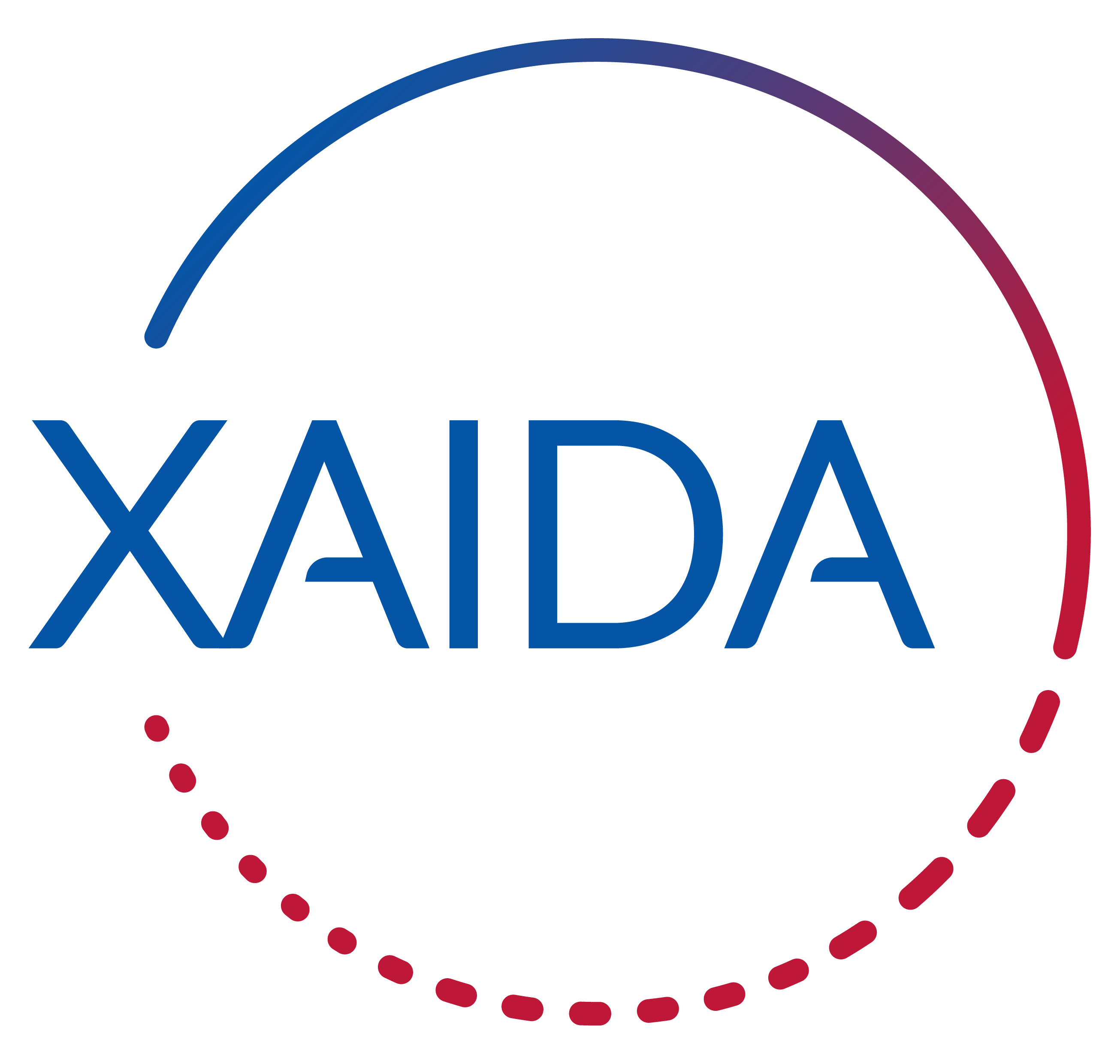Value Promotion Plan
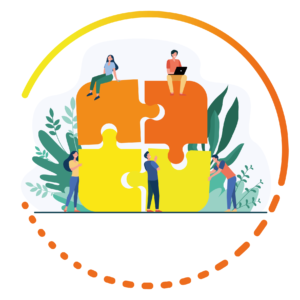
To raise awareness about the extreme weather events challenges and to disseminate our expertise, the XAIDA teams have to be credible and efficient. We apply to our framework, publications, methods, team efforts but also in our workshop, recruitment process and every governance decision those values:
- Clarity
- Transparency
- Engagement
- Relevance
- Impacts
- Accessibility
- Inclusivity
The Value Pormotion Plan details below how to articulate those values with our projects and objectives.
To achieve the objectives of the project, XAIDA brings together teams of specialists in extreme event attribution, atmospheric dynamics, climate modelling, machine learning and causal inference.
The project gathers sixteen institutions across Europe and 60 persons. The close network and collaboration among those institutions make the large XAIDA network up to 75-80 persons. In order to make everyone comfortable and able to work in the best conditions, all the institutions have HR rules, ethics and values.
However, it is important that the XAIDA members collaborating for four years, have their own ethics and values to promote and to create a sense of community despite geography, language and specialty.
A value promotion plan (VPP) for such a project highlights and communicates the value that the project will bring to the organization (the European Commission), its own community (the XAIDA members) and its stakeholders. This develops messaging to communicate the benefits and complete the Communication, dissemination and exploitation strategy that identifies target audiences and the best ways to reach them. The goal of a VPP is to generate support for the project and ensure that the project members and the stakeholders understand and are motivated about the value it will bring.
In that end, we have elected members to be part of a Promotion Committee (PC) in charge of the promotion of the values and the watch of the crossing internal (and sometimes external) topics that concern the community. Their recommendations lead us to consider inclusivity and communication both internal communication and external with the Stakeholders, to be our main values to work on but also to promote publicly.
The Promotion Committee and their recommendations
The purpose of the Promotion Committee (PC) is to design a gender balance strategy including measures aiming at a balanced participation of women and men in the consortium activities and decision making. Moreover, the EU is a strong supporter of equality and inclusivity in research and innovation. This strategy also intends to integrate fairness in recruitment of young scientists, climate and environment friendliness, communication of the project results and climate science knowledge to communities unfamiliar with climate change issues, and potential ethics issues.
Composed of 4 members and one observer, elected by the Governing Board in the first year of the project, they have made several strategic recommendations to managing teams of the project regarding cross-cutting topics:
1) gender balance and equality in the research team;
2) respect of ethics and deontology;
3) climate and environment communication and dissemination.
The recommendations are based on what was in the initial proposal, the ethics reports, the dissemination plan and a survey among XAIDA participants on gender balance and equality.
The feedback and analysis can point out challenges, issues, remarks or propositions to approach the community and its diversity and promote our values.
Inclusivity, ethics and gender balance
The ethics in the VPP aim to ensure that the research is conducted in an ethical and responsible manner, with due consideration given to the potential impact of the research on society and the environment, addressing any ethical concerns that may arise, ensuring inclusivity and equity, and providing transparency and open communication throughout the research process. The ethics in research are ongoing thanks to various charts and agreements Universities, Laboratories, Institutions, Governments and the European Union have put in place. However, inclusivity and equity, even if they are values promoted by all the institutions, have to be promoted by our consortium so the challenges our teams are facing can be discussed and even solved in a safe and open workspace.
To ensure Inclusivity and gender Balance in the project, we have several goals:
- Addressing any potential biases or ethical concerns that may arise during the research process (recruitment, communication, personal data, privacy, etc.);
- Ensuring that the project is inclusive and equitable, with due consideration given to the impact of the research on underrepresented groups and marginalized communities;
- Providing transparency and open communication throughout the research process, including the sharing of data, methods, and results in a responsible and ethical manner;
- Encouraging the participation of diverse perspectives in the research process, including the perspectives of underrepresented groups and marginalized communities;
- Continuously reviewing and updating the value promotion plan as the project progresses and new concerns may arise.
Those are generic goals. However, the strategy and values we are promoting to reach those 5 objectives are specific to XAIDA and its community. The PC and the decision-making boards have raised topics and challenges that the community is facing to design this plan.
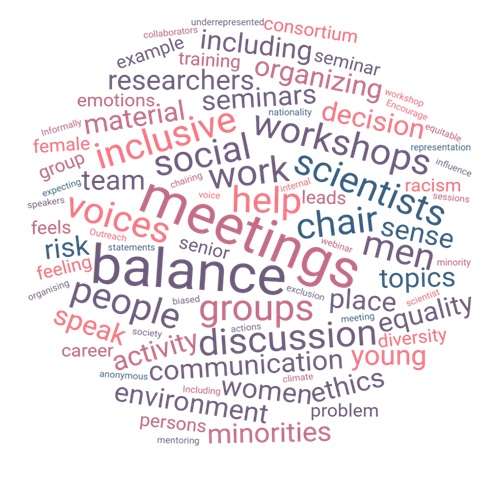
Figure 1 – Tags cloud of the answers at the Gender Balance question (PC Survey – 2022)
The first decision was to talk about equality and inclusivity (for a lot of other reasons too) and not only gender balance. Figure 1 above shows the recurrent words from the answers collected in the survey. There is a clear need for balance, meetings and inclusive work among the XAIDA community. We are still facing challenges with the gender balance in the project but integration and raising awareness regarding the integration of the minorities or of the Early Career Scientists are also part of our inclusive values.
Gender Balance in XAIDA
There was a clear unbalance at the gender level in the project and especially at the governing level, from the very beginning. The Promotion Committee and the Managing team have made an assessment of the situation. This issue is not specific to the project; the issue concerns Science in Europe, especially Physics, Climate sciences and AI. According to Huang, Gates, Sinatra & Barabási (2020), women are underrepresented (number of publications, length of careers, key positions, etc.) in Science in general. The trend tends to be more balanced the past 10 years but the gap still exists. A 2021 publication of the OECD suggests that the gender gap in research is more important in Computer Sciences (25% of corresponding authors) and Earth and planetary sciences (about 21% of corresponding authors). The lowest percentage of corresponding authors remains physics and astronomy with 13%.
Keeping those figures in mind, the XAIDA project is one of the most balanced Computer and Physics research projects (see figures 1 and table 3 below). As per reference, the total official number in February 2023 of the XAIDA members was 60. We did not take in account the observers, associated members, occasionally collaborators or the External Advisory Board (here counted as associated members) for the figures.
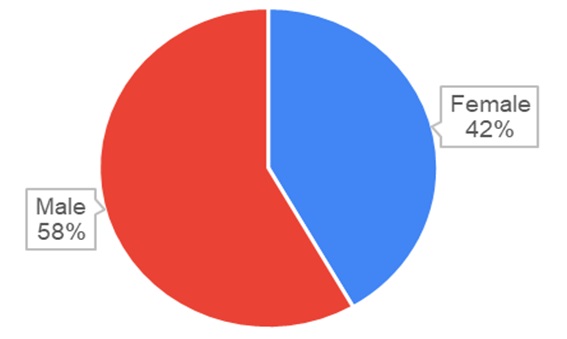
Figure 2 – Percentage of men and women in the XAIDA project
The issue in the general gender balance of the project resides in the categories. Women are underrepresented in the Senior positions with 38% of male (table 3). The WP leaders, Seniors, experience the same gap: 16 leaders, 4 women and 12 men. That means only 25% of the WP leaders are women.
Table 3 – Gender balance by categories in the XAIDA project (ECS = Early Career Scientists).
% of Gender by category | ||||
| Female | Male | Total | |
ECS | 18% | 20% | 38% | |
Senior | 23% | 38% | 62% | |
Total | 42% | 58% | 100% | |
Through the first months on the project, the WP leaders have included more leaders and more ECS in the leading decisions. The Governing board has grown with new scientists strongly involved in the project, to lead and manage the project. At the beginning the leading positions were ⅓ women and ⅔ men (21 members, 7 women and 14 men), today, there are five more persons: 26 members with 9 women and 17 men that represents a slight improvement with 34,6% female at the governing level.
To make it more equal, the other boards, such as the PC and the EAB are perfectly balanced (in PM efforts). However, the Project Office (Managing team) counts only 3 members and includes the Project Manager who is a female and two Senior Scientists (males). The PC indicates that, under the 40 answers they had, more male than female indicate they are involved in several rather than one work package. However, among the people that answered the survey, taking part in boards or commissions seems to be felt equally divided between male and female. The need of guidelines and of raising awareness to create a safe space for discussion and for inclusion of the women at the decision-making level remains demanded by the XAIDA team.
The figures (figure 2 and figure 3) above show that the Gender balance issue is not as strong as it was initially planned in the proposal, at the general level, thanks to recruitments and ECS. Nevertheless, the PC survey raises the question of inclusivity. Creating a more inclusive and equitable work environment is a major challenge in the XAIDA community. The goal of this strategy is to create an inclusive and equitable environment for all members of the project team, regardless of their gender, race, ethnicity, sexual orientation, ability or other characteristics.
Equality and inclusivity
Inclusivity in gender equality also includes being inclusive of non-binary individuals. This can be a challenging aspect for a project to manage, as non-binary identities and experiences may not be as well understood or acknowledged as binary identities. Some points highlighted in the survey and by the PC to be more comfortable with these questions is to educate themselves and their team members on non-binary identities and experiences. Additionally, it is important for the project to actively seek out input and feedback from non-binary individuals and to make sure that their perspectives are being considered and incorporated into the project.
To promote inclusivity in gender equality, the project will take a number of actions, such as:
- Raise awareness: providing training and education on non-binary identities and experiences for all team members.
A lot of answers from the survey highlight the fact that there were no issues or that the equality/gender balance question was not a topic to discuss. Other answers pointed out that remarks or incomprehension in front of this topic show the need for sensitization through specific workshops or webinars.
- Ensuring that all language and communication used within the project is inclusive and respectful of non-binary individuals.
- Actively seeking out and incorporating feedback from non-binary individuals in the project. Taking into account the responses at the PC survey — that was the first step — we can consider to follow the evolution of the questions and issues raised with other qualitative surveys and/or other solutions that the PC will propose during the rest of the project.
It is important to remember that inclusivity and gender equality are an ongoing process and it requires continuous effort and commitment to make sure that all individuals are respected and included. This challenge also concerns the minorities, in particular the different ethnicities.
The most challenging actions would be to include non-binary persons and/or minorities at the decision making level. The boards and team leaders are originally the makers of the project and it has been decided often several years before the beginning of the project. Knowing that, the main actions the XAIDA community can make is to promote inclusivity. The goals are concerning all people in the project: non-binary, ethnicities, field of specialties, etc.
- The first goal would be to create a positive work environment: foster a culture of inclusivity and respect by promoting open communication, actively listening to and addressing concerns, and holding team members accountable for their actions.
- Secondly, encouraging feedback: solicit feedback from minority team members to understand how they experience the work environment and identify areas for improvement.
- Measure progress: track progress towards diversity and inclusivity goals, and adjust strategies as needed.
- Finally, be aware of the intersectionality and be inclusive of multiple minorities at a time.
This is a general outline and we have to keep in mind that this is an ongoing process and not a one-time solution. The challenges are going way beyond the project itself and could help the XAIDA members for their professional life, in the project and outside/after the project.
As for the values we have started to be well implemented, the integration of the ECS was an issue raised from the beginning of the project and the tools and strategy came with a bottom-up impulse. We can still promote it in teams and institutions. Our internal and external communication strategy will help to promote the inclusion of the ECS and minorities in the different aspects of the project life.
Internal Communication
It has been very clear that internal communication and dissemination at the teams level need improvements. What are the actions and measures we can promote, at a management level, to solve it? XAIDA is not a policy making programme for universities and HR labs. However, we can provide guidelines to promote values and create an ethics and inclusive workspace.
An inclusive internal communication means creating a virtuous synergy between teambuilding and integration. Indeed, with sixteen partners and teams across the units, we need to reinforce the way of collaboration and of sharing the results and the work between all of us, in an inclusive and transparent way. The internal tools and the internal strategy have to be reinforced with new goals and framework for the rest of the project. We can summarize our values and strategy such as figure 4 below. This figure explains the four main points
- Transparency: information, dates, events, methods and ongoing work as well as templates and documentation should be known by everyone in order to be able to know the orientations and to be able to discuss the orientations and decisions.
- Team building: Better knowing the teams and field of specialty of each other while encouraging active participation from all team members in project communication and decision-making.This value is very important but difficult to reach. The teams are divided across 16 partners in 7 different European countries. A part of a team is even currently in the US. The distance of the teams, remote meetings and webinars, increases the difficulty of creating an XAIDA community.
Nevertheless, the AGAs and in-person workshops are welcome to get to know more about each other. The creation of internal sub-groups such as the ECS group, has helped a lot with the integration of the PhD students for example, but also to make the teams more dynamic. Integrating members of this group in the management discussions and opening the Governing Board to ECS was also a big step towards team building and integration.
- Inclusivity: promote ethical values, inclusive language and positive behaviors in order to make everyone comfortable.
- Integration: making common methods and tools for common results in order to have the feeling of a community.
- Feedback and improvements: continuously gathering and incorporating feedback to evaluate and improve the communication.
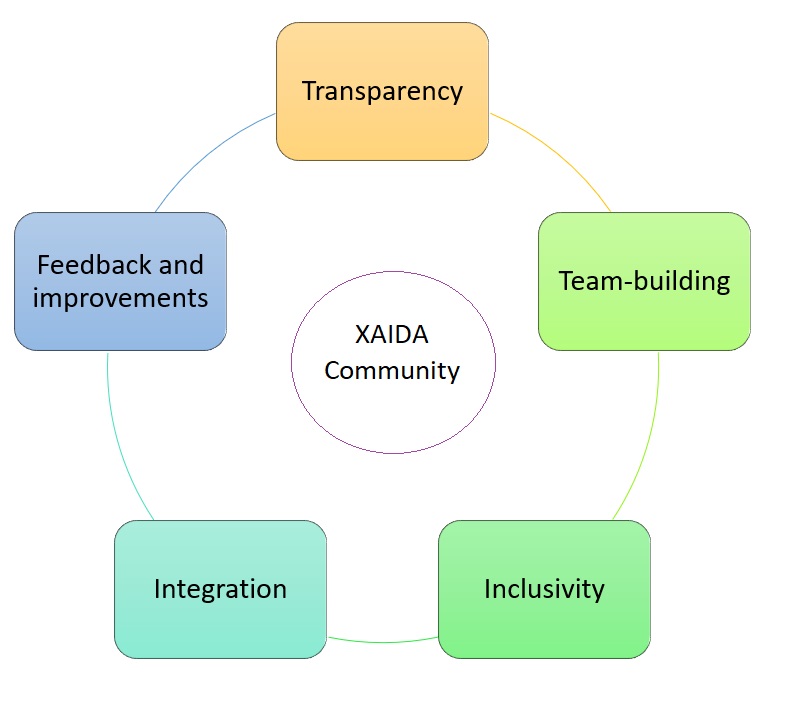
Figure 3 – The XAIDA internal values
The values described here, designed following the recommendations of the PC, have helped draw an internal communication strategy. It should aim to create a culture of open, transparent, and inclusive communication, where team members feel comfortable sharing their ideas and feedback, and where ethical values and fairness are emphasized and actively promoted.
Communication outside XAIDA
The Communication strategy of the XAIDA project ensures three main goals:
- Increase awareness and understanding of the project among key audiences, such as government agencies and insurance companies, in order to generate support and funding for the project.
- Communicate the project’s key benefits in order to demonstrate the value it will bring to the community and stakeholders.
- Ensure wide dissemination of the results to the scientific community and general public in order to maximize the impact of the research and foster collaboration and innovation.
To reach these general goals, we intend to promote the accessibility of the results and research itself to the general public in outreach activities working together with stakeholders.
Scientific dissemination
The PC survey and recommendations pointed out the need for support regarding the outreach activities that researchers can do (see figure 4 below). The project designed a dissemination strategy of the research and results that, along with the communication strategy, aims to reach the general public, media, non-technical public and so on.
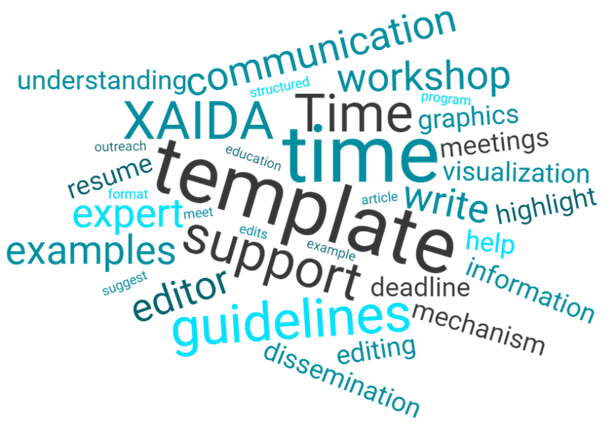
The main highlight of the first year of the project is that reaching the general public and being accessible to any kind of person is urgent to promote inside the project. The actions need to be put in place and especially to develop the website and reach more visibility outside the scientific community or the targeted stakeholders.
We especially have two actors engaged in outreach activities with primary school teachers. They develop innovative methods for education on climate and science and have international reach which will enable the realization of the following outcomes: improve scientific understanding of future events and preparedness through training; promote climate justice, ethics and solidarity and increase the attractiveness of mitigation and adaptation solutions; contribute to the necessary effort on climate education emphasized in the Paris agreement (art. 12).
Primary school readers and/or students, media, general public, all our activity engaging external people in our project answers to the need for ethics but also clarity, the messages have to be accessible to non-experts, and transparency. It has to be relevant and reflect the expertise of our teams. The activity and language we use should be inclusive and sustainable: we want to create an engagement from the general public, encouraging participation and feedback through public events, social media, interactive activities and/or resources, in a long-term perspective so the results and benefits of the project go beyond the end of XAIDA. Indeed, the impact of the project on society and environment are going beyond the project itself, so are the values and the messages. It can be synthesized with the virtuous circle below (Figure 5).
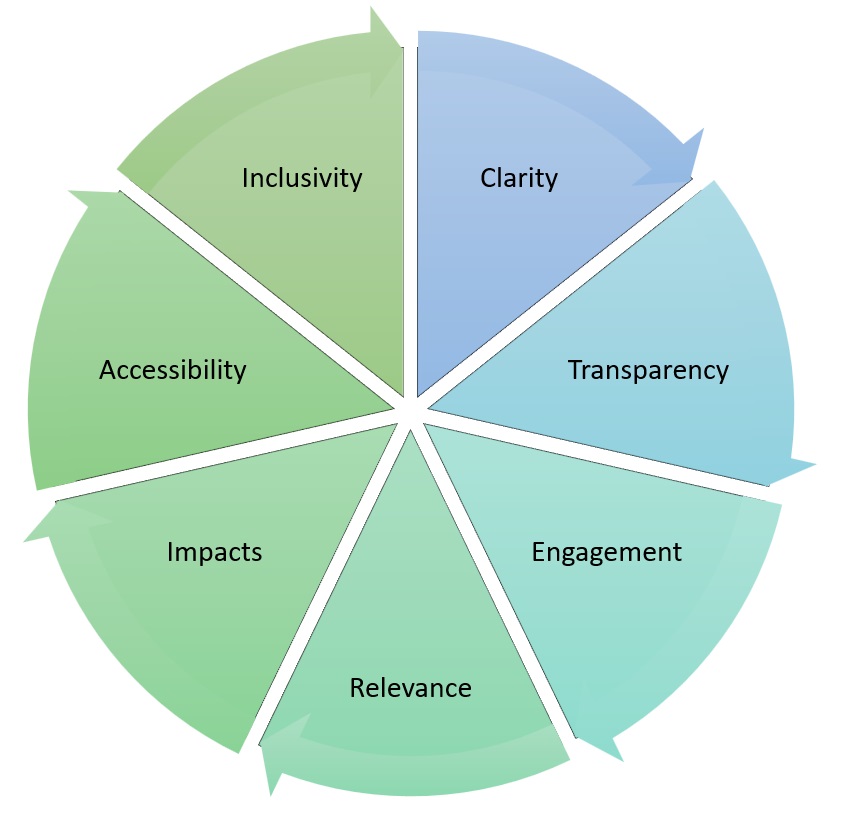
The project will provide templates, training sessions and guidelines, respecting all the values defined above, to the groups of people willing to work on making the science accessible and more impactful for the general public and other targeted groups.
Stakeholders partnership
Since the very beginning, XAIDA was meant to be a dissemination and impactful project working together with stakeholders and improving climate services. A large part of the activity of the project is devoted to stakeholder interactions to maximize impacts. The Grant Agreement and proposal of the project explain that “XAIDA will have impacts by enhancing adaptive capacity and action on adaptation to reduce vulnerability; improving information for climate services and decision making; strengthening knowledge on climate. In addition, XAIDA will help prepare young generations to live in a changing climate by strengthening their knowledge”.
The XAIDA objectives answer several values that can be applied to all our relationships with the Stakeholders, in addition to the general values we have explained in the other sections of this plan. Our communication channels (also called the Dialog platform) answer to the principles of credibility, expertise, efficiency and partnership that reflect our work. In other words, the scientific questions asked in the project reflect the adaptation concerns of stakeholders, and result in tailored scientific outputs that match the scale of decision-making, facilitating stakeholders to take early action on adaptation. The stakeholders following the project are consulted and the scientific work adapts itself to their needs. It has already been the case for the event definition but also the decision of the set of the 6 central case studies.
To summarize, flexibility and compliance are the heart of our strategy: open to adjustments based on the feedback the stakeholders are making to us and compliance with relevant laws, regulations and industry standards.
Finally, as planned in the project proposal and in the Grant Agreement, we have an open science policy and make all results data sets and software developed accessible. This will allow consultancies and climate services to become beta-testers of software and data. Dedicated training sessions will take place once a year back to back to general assemblies. The tools are proposed for evaluation to the stakeholders and feedback will be sought.
